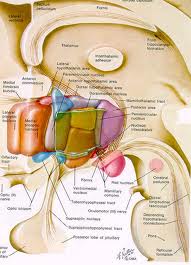Fifth Columnist of the Mind
Dolors & Sense
by Sanford Rose
KISSIMMEE Florida—(Weekly Hubris)—3/12/12—The locution now stirs few remembrances.
It did once. In 1936, four armed columns marched on Madrid.
A fifth within the city stood ready to open its gates to the enemy.
The expression “fifth columnist” was synonymous for the next 20 years with execrable treason.
Our brains routinely perform such an act of sabotage.
The locus of initial treachery is precisely identified. It is the hypothalamus, an almond-sized section of the mid-brain that sits, predictably, below the much-larger thalamus.

It anchors an axis of three organs—the hypothalamus, the pituitary, and the adrenals.
Dysregulation of the HPA axis is responsible for most of the ills that plague us.
An overactive axis produces central obesity, diabetes, depression, hyperthyroidism, irritable bowel syndrome, insomnia, etc., etc.
An underactive axis bestows post-traumatic stress syndrome, chronic fatigue, fibromyalgia, asthma, hypothyroidism, etc., etc.
What is the etiology of this perfidious dysregulation?
The axis’s central purpose is to modulate chemically the “flight or fight” response; to proportion a reaction to a stressor that does the least damage to basic metabolic processes.
We all know what stressors are. They can be extrinsic or intrinsic, real or imagined. The mugger on the street; the mugger in our psyche.
When stress surfaces, the hypothalamus chemically emails the pituitary gland corticotropin-releasing factor (CRF) and arginine vasopressin while simultaneously activating the body’s epinephrine/norepinephrine system.
The pituitary responds by emailing the adrenals adrenocorticotropin hormone (ACTH).
The adrenals complete the transmission by manufacturing cortisol and dehydroepiandrosterone for the needs of the body’s cells.
They also recycle cortisol to the hypothalamus and the pituitary, which, in a negative-feedback maneuver, serves to damp down the initial CRF and ACTH outputs.
If all goes well, the body makes the appropriate response to the stressor and quickly returns to homeostasis.
All does not always go well.
When the body is subjected to continual stress, the modulatory system erodes and breaks down.
For example, when we fall into deep sleep, which lasts only about 30 to 50 minutes a night if we’re lucky, the secretion of cortisol from the adrenals decreases, allowing the body and mind to recover from the day’s flight-or-fight adventures.
But, if our stress is caused by a controlling boss who derides our work performance, then the anticipation of tomorrow’s misadventures, and those of many days thereafter, may prevent us from falling into deep sleep.
The prolonged absence of deep sleep could initiate a positive (read negative) feedback loop of increased cellular cortisol, leading to even more sleep fragmentation, causing still more cortisol.
Chronic hypercortisolism interferes, among other things, with the body’s glucose metabolism, auguring diabetes.
Thus is the chief regulatory axis of the mind persuaded to embark on a path to betraying its master and becoming, as it were, a true “axis of evil.”
2 Comments
barbara Kalmoutis
thank you very much for a very interesting and informative article…Barbara
srose
You’re very welcome. I hope you enjoy some of my other pieces.
S. Rose